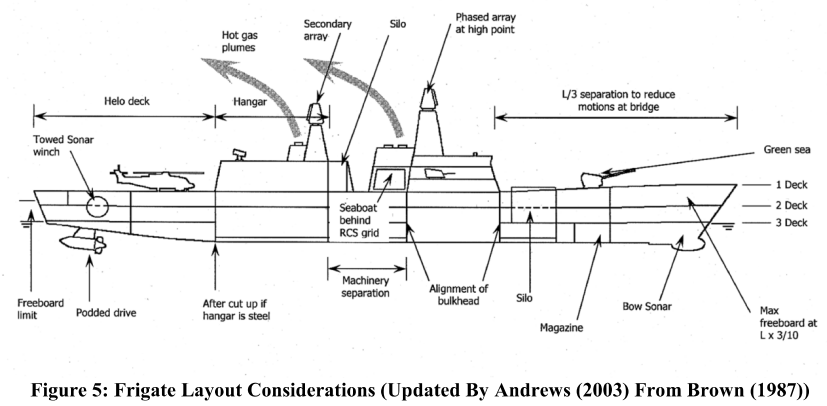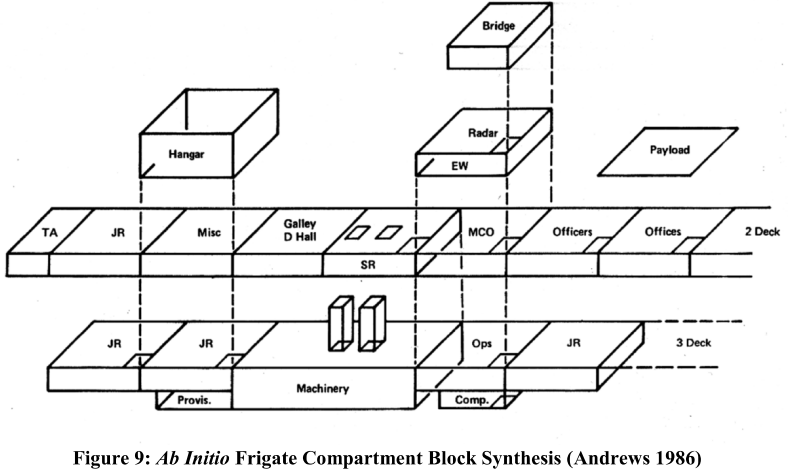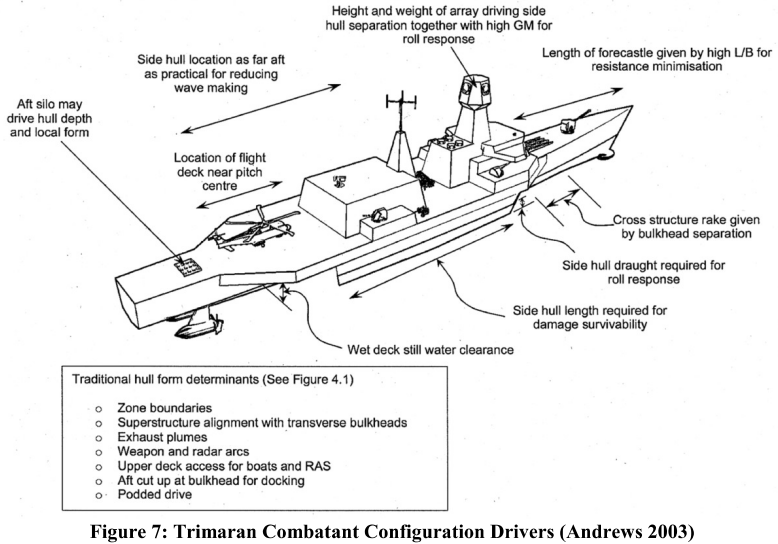Warship Rules of Thumb & Design Guidance
Originally posted here on the Shipbucket forums. Created by RP1 (http://www.rp-one.net/)
Hello Everybody!
As a companion to the reading material thread, I am going to put examples of design guidance, rules of thumb etc here.
General Layout Guidance
Some summary images for surface warship layout, taken from the SOTA report to IMDC 2012:
http://repository.tudelft.nl/view/ir/uu ... 242027c82/
Typical frigate layout considerations:
A generic frigate internal arrangement, at a high level:
Typical trimaran layout considerations:
Sizing and Proportions
For frigates, typical values are shown below. There are always differences. National standards and "style" play an important part, as to external influences and innovations. When producing a design, consider comparing these ratios against the suggested limits and other ships produced by the same navy, or with similar features.
Also note that many published dimensions are deceptive. Those for the RN Type 23 frigate, for example, are overall, seemingly including the sonar dome in the draught.
• Waterline beam to draught ratio is usually around 3.25, where draught is to the keel.
• Midships depth to draught ratio for a modern frigate or destroyer should properly be defined based on the hullform parameters but usually ends up at about 2.25.
• Waterline length to midships depth ratio should not exceed about 13 for steel surface warships. Higher ratios will require more and more expensive structure.
• Circular M: Part of the Admiralty notation. Circular M is defined as: Waterline length in m / cube root of volume of displacement in m3. Circular M for a frigate would typically be around 7.
• Overall density: The overall density of warships decreased from the days of guns and armour and more recently seems to be decreasing due to larger hangars and mission bays. This will also tend to increase the depth/draught ratio.
Some typical values are, in Te/m3: - Submarines: Just under 1 - Frigates and destroyers: 0.25-0.3 - Carriers: 0.25 - Auxiliaries: Somewhere between 0.3 (container ship like) to 0.75 (tanker like)
• Freeboard forward: This is a matter of surprising contention. One rule of thumb is that, where A = freeboard and L = waterline length, then (100 x 2 x A)/L should be in the range 12-14.7. This is from British guidance, however, and may be excessive for vessels with more limited areas of operation.
Structures
The primary structural loading experienced by large ocean going vessels is longitudinal bending – as waves pass the ship, the change in buoyancy acts with the weight distribution to bend the whole vessel. As sea states worsen, this static or quasi-static load is enhanced by a range of dynamic phenomena such as slamming, springing and whipping. This longitudinal bending is highest amidships. It is this loading that leads to the Length/Depth limitations discussed above – consider the ship as an “I” beam, where the upper and lower flanges are the upperdeck and keel.
Shorter and lower displacement ships tend to experience less longitudinal bending. For fast-attack craft the primary structural load may actually be slamming pressures when operating in a high speed, semi-planning mode.
This longitudinal loading has a number of influences on layout.
Structural Continuity
Discontinuities or breaks in the structure are a bad thing. They result in stress concentrations and can lead to cracking.
A very short superstructure will generally not experience the longitudinal bending, most practical superstructure blocks will experience some, whereas long superstructures will experience a lot. This means that they need to be both compatible in bending and have good detail design at the ends, which are effectively a sudden reduction in the depth of the “I” beam and thus are stress concentrations.
The superstructure ends will try to lift off of the hull. If they are just welded onto the deck then the deck will crack, so instead they are aligned with the main transverse bulkheads in the hull. Sometimes this is not quite possible due to late changes etc. or is insufficient and additional structural integration is needed. Close examination of some ship designs (Type 053, 054, 23, LCS-2) will show this – the curved transition pieces at the ends of the superstructure are to ensure good structural integration.
Sometimes it is possible to get away with it if you add a large frame or a non-watertight bulkhead extending a single deck below the end of the superstructure. This would usually be heavier, however – but it is used on the Danish Absalon and others.
Similarly, major changes in the width of the superstructure (or box in a trimaran) should ideally line up with bulkheads. The FFG-7 arrangement with a “waisted” superstructure is quite difficult to integrate, so is undesirable, particularly amidships. As the FFG-7 showed, it can be done of course.
Holes in Decks
Having said that longitudinal bending is highest amidships and that the deck is very important, we now see that most ships have massive holes in it for the GT ducting etc. Unsurprisingly, this can be a source of cracking and detail design is required, along with additional structure in the remaining deck. Container carriers are an extreme example of this (they have no upperdeck to speak of) and can have very thick structure on the upperdeck amidships.
Generally, we want holes in the upperdeck to be as narrow as possible, so that they remove the least structural material from the POV of bending. Holes (including hatches) should line up along the ships length (makes the structural design a lot easier as stiffeners are continuous), and smaller holes may be placed immediately before or after large ones with no effect on the structural strength.
What one should avoid is having several cut-outs in close proximity with poor alignment, as this creates small, highly loaded areas of structure between them. It is very easy to end up doing this with internal lifts on aircraft carriers.
Holes in the Side Shell
The side shell is acting like the web of the I-beam and so is quite important, although it is usually very light structure in comparison to the decks. Fortunately, most large openings are in the superstructure which is less heavily loaded and it is frequently possible to arrange a longitudinal bulkhead somewhere inboard (like in a boat bay). As the size of US carriers grew they had to switch from a structurally “external” hangar (it was like a large superstructure) to an “internal” one (the flight deck became effective in resisting longitudinal bending). Of course, they still wished to retain the deck-edge lifts, and so the solution was some careful structural design to build in a big portal – hence the curved ends of the lift opening.


